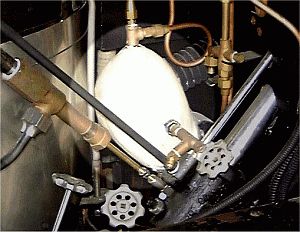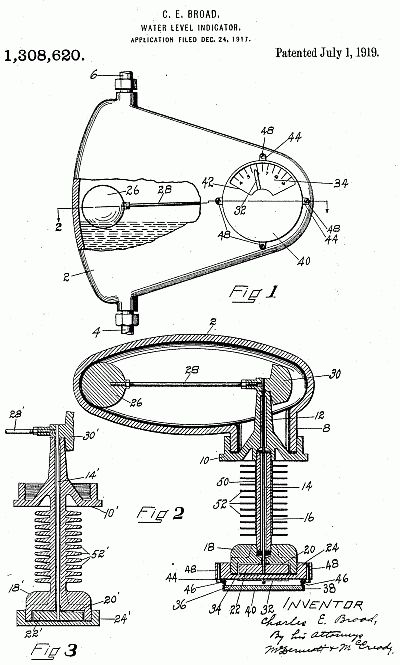
the kidney water level indicator's cast housing is mounted to the boiler side of the firewall and contains a counterbalanced float assembly

located on the dash at floorboard level and just behind the brake pedal the boiler water level indicator displays the amount of water in the boiler
Stanley Motor Carriage boilers generate higher steam pressures (nominally 500 PSIG) than steam traction engine or locomotive boilers (100 PSIG to 200 PSIG). To display the boiler water level in traction engine and locomotive boilers a "water glass" is used. A water glass consists of a heavy-walled glass tube enclosed in a rugged housing such that the glass tube is connected between the bottom (below the water level) and top (in the steam area of the boiler) of a traction engine or locomotive boiler. The water level in the boiler and water level in the water glass seek the same level and thus the amount or level of water in the boiler may be displayed.
However, the pressures present in Stanley boilers negate the use of such devices due to shattering of the glass indicating tube. As a result the Stanley twins invented a device that generally became known as the "three-tube indicator". This ingenious and novel device functions much like a standard boiler water indicator or "water bottle" as they were nicknamed but the glass indicating tube is subject to atmospheric pressure and not the actual boiler pressure as is the case with conventional traction engine or locomotive water glasses. The downside of the three-tube indicator is that unless well maintained it can malfunction and provide a false reading.
Beginning with the introduction of the Model 735 Stanley the three-tube indicator was replaced with the "kidney water indicator". This device incorporated a heavy cast housing that could withstand the boiler pressures present. Inside the housing was a counterbalanced solid metal float that rotated a magnet. The pointer of the indicator was magnetically coupled to the position of the magnet and thus no seals were present that could leak. A long neck with cooling fins was provided to radiate the heat away from a shaft that connected the float mechanism inside the kidney-shaped float enclosure with the magnetic indicator. The device the Stanley's used received Patent Number 1, 308,602, was patented by George E. Broad and was assigned to the Stanley Motor Carriage Company.
